Nursing Solved Assignment (Doc)
VerifiedAdded on 2021/06/15
|12
|2527
|67
AI Summary
Contribute Materials
Your contribution can guide someone’s learning journey. Share your
documents today.
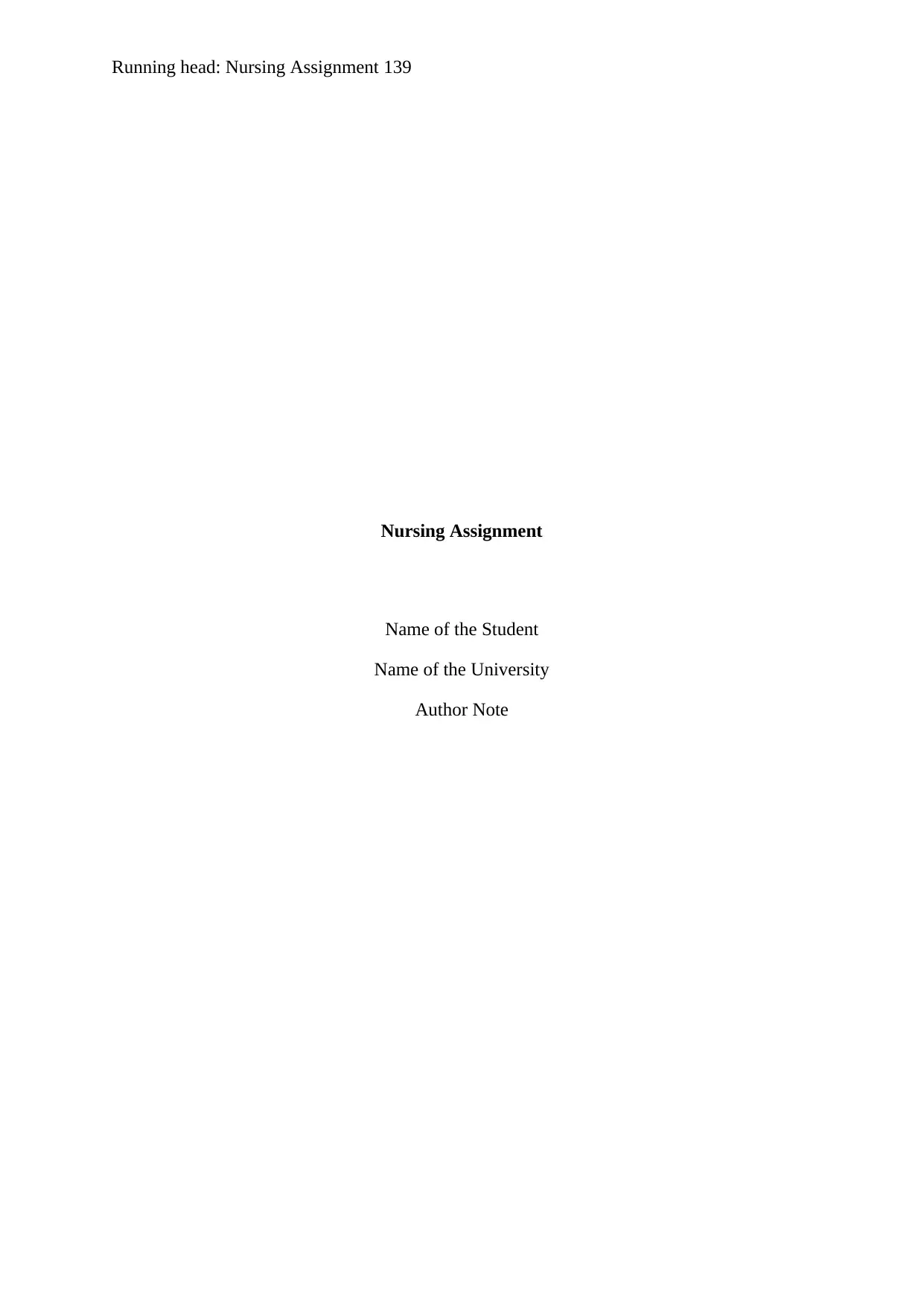
Running head: Nursing Assignment 139
Nursing Assignment
Name of the Student
Name of the University
Author Note
Nursing Assignment
Name of the Student
Name of the University
Author Note
Secure Best Marks with AI Grader
Need help grading? Try our AI Grader for instant feedback on your assignments.
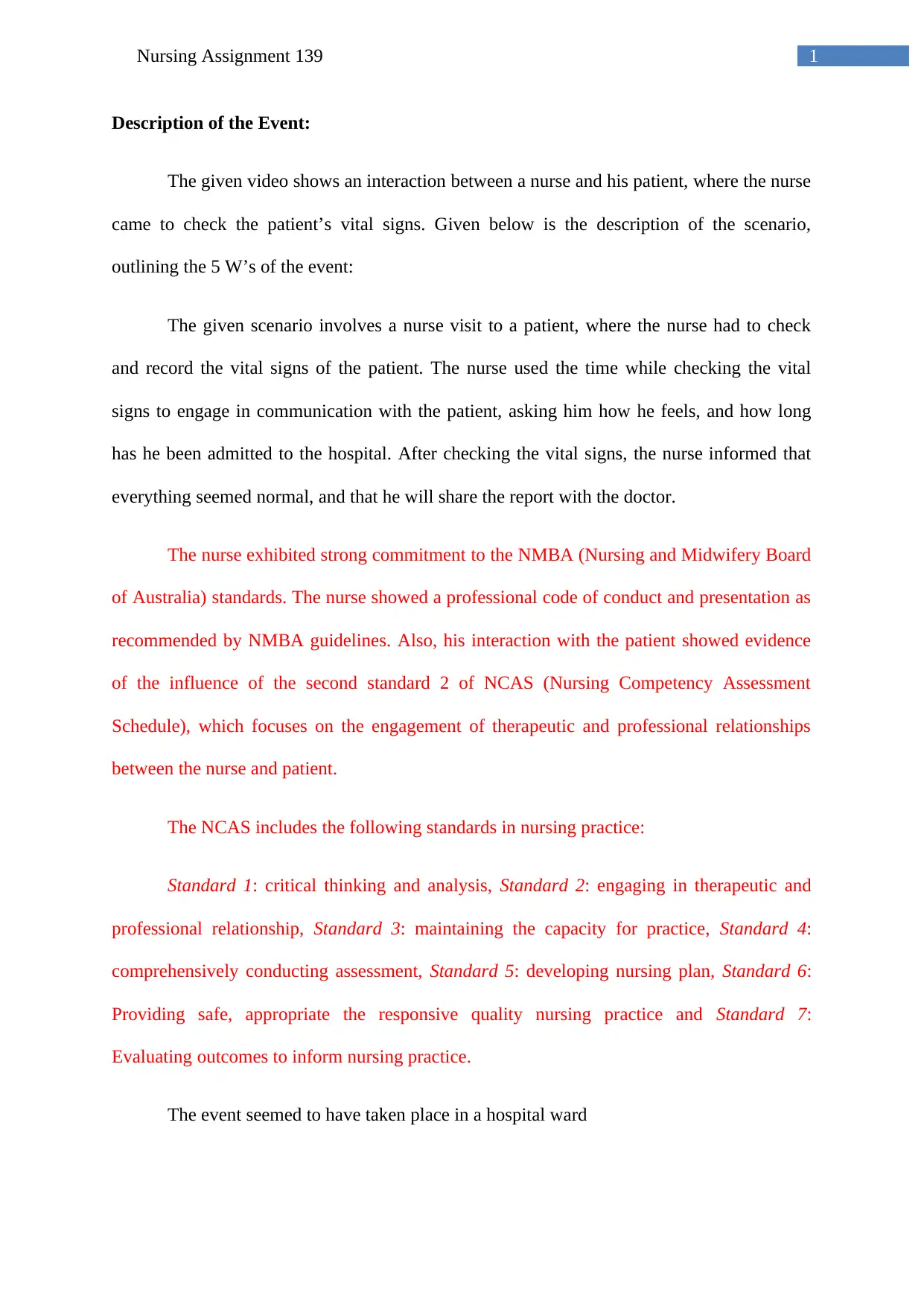
1Nursing Assignment 139
Description of the Event:
The given video shows an interaction between a nurse and his patient, where the nurse
came to check the patient’s vital signs. Given below is the description of the scenario,
outlining the 5 W’s of the event:
The given scenario involves a nurse visit to a patient, where the nurse had to check
and record the vital signs of the patient. The nurse used the time while checking the vital
signs to engage in communication with the patient, asking him how he feels, and how long
has he been admitted to the hospital. After checking the vital signs, the nurse informed that
everything seemed normal, and that he will share the report with the doctor.
The nurse exhibited strong commitment to the NMBA (Nursing and Midwifery Board
of Australia) standards. The nurse showed a professional code of conduct and presentation as
recommended by NMBA guidelines. Also, his interaction with the patient showed evidence
of the influence of the second standard 2 of NCAS (Nursing Competency Assessment
Schedule), which focuses on the engagement of therapeutic and professional relationships
between the nurse and patient.
The NCAS includes the following standards in nursing practice:
Standard 1: critical thinking and analysis, Standard 2: engaging in therapeutic and
professional relationship, Standard 3: maintaining the capacity for practice, Standard 4:
comprehensively conducting assessment, Standard 5: developing nursing plan, Standard 6:
Providing safe, appropriate the responsive quality nursing practice and Standard 7:
Evaluating outcomes to inform nursing practice.
The event seemed to have taken place in a hospital ward
Description of the Event:
The given video shows an interaction between a nurse and his patient, where the nurse
came to check the patient’s vital signs. Given below is the description of the scenario,
outlining the 5 W’s of the event:
The given scenario involves a nurse visit to a patient, where the nurse had to check
and record the vital signs of the patient. The nurse used the time while checking the vital
signs to engage in communication with the patient, asking him how he feels, and how long
has he been admitted to the hospital. After checking the vital signs, the nurse informed that
everything seemed normal, and that he will share the report with the doctor.
The nurse exhibited strong commitment to the NMBA (Nursing and Midwifery Board
of Australia) standards. The nurse showed a professional code of conduct and presentation as
recommended by NMBA guidelines. Also, his interaction with the patient showed evidence
of the influence of the second standard 2 of NCAS (Nursing Competency Assessment
Schedule), which focuses on the engagement of therapeutic and professional relationships
between the nurse and patient.
The NCAS includes the following standards in nursing practice:
Standard 1: critical thinking and analysis, Standard 2: engaging in therapeutic and
professional relationship, Standard 3: maintaining the capacity for practice, Standard 4:
comprehensively conducting assessment, Standard 5: developing nursing plan, Standard 6:
Providing safe, appropriate the responsive quality nursing practice and Standard 7:
Evaluating outcomes to inform nursing practice.
The event seemed to have taken place in a hospital ward
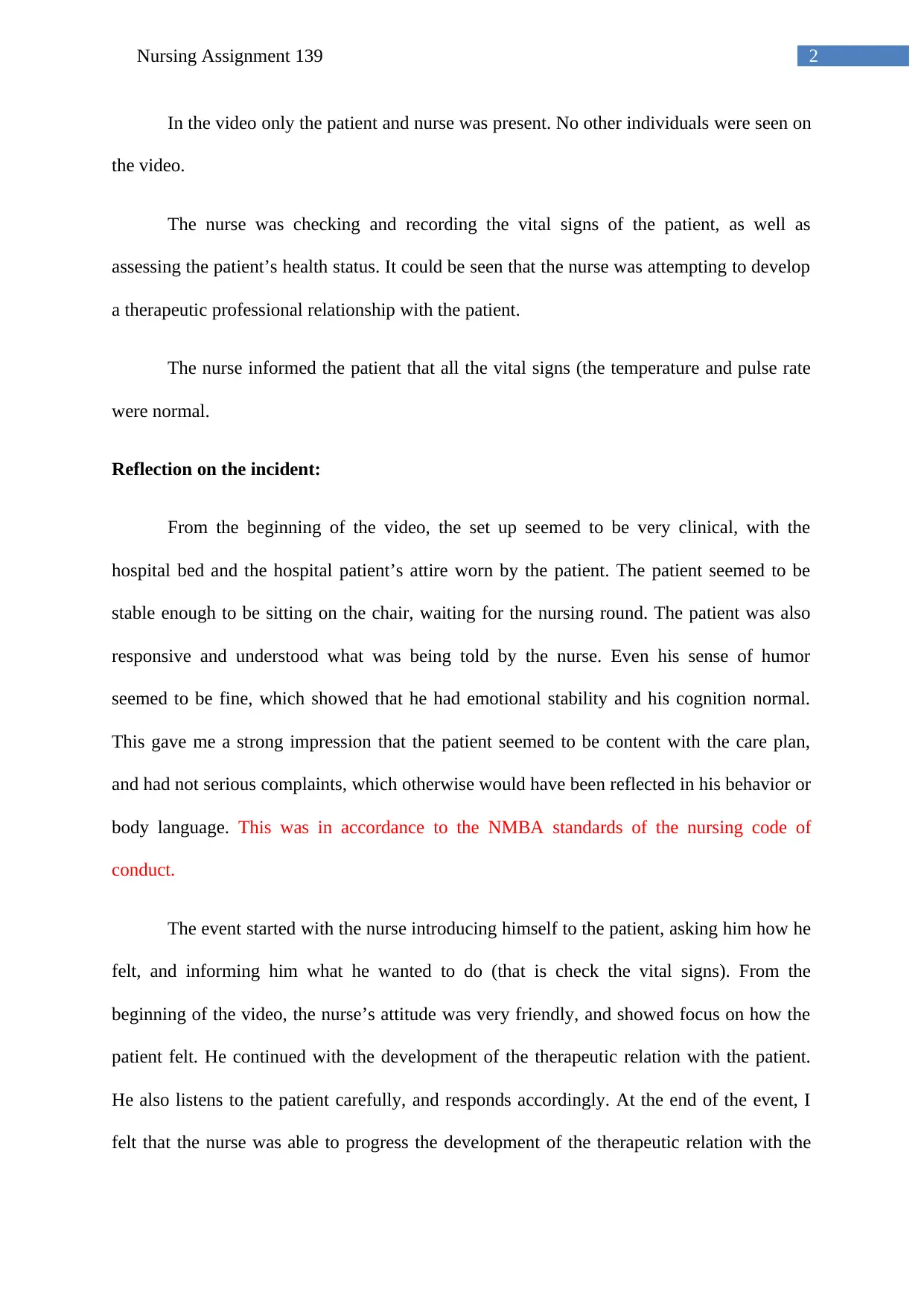
2Nursing Assignment 139
In the video only the patient and nurse was present. No other individuals were seen on
the video.
The nurse was checking and recording the vital signs of the patient, as well as
assessing the patient’s health status. It could be seen that the nurse was attempting to develop
a therapeutic professional relationship with the patient.
The nurse informed the patient that all the vital signs (the temperature and pulse rate
were normal.
Reflection on the incident:
From the beginning of the video, the set up seemed to be very clinical, with the
hospital bed and the hospital patient’s attire worn by the patient. The patient seemed to be
stable enough to be sitting on the chair, waiting for the nursing round. The patient was also
responsive and understood what was being told by the nurse. Even his sense of humor
seemed to be fine, which showed that he had emotional stability and his cognition normal.
This gave me a strong impression that the patient seemed to be content with the care plan,
and had not serious complaints, which otherwise would have been reflected in his behavior or
body language. This was in accordance to the NMBA standards of the nursing code of
conduct.
The event started with the nurse introducing himself to the patient, asking him how he
felt, and informing him what he wanted to do (that is check the vital signs). From the
beginning of the video, the nurse’s attitude was very friendly, and showed focus on how the
patient felt. He continued with the development of the therapeutic relation with the patient.
He also listens to the patient carefully, and responds accordingly. At the end of the event, I
felt that the nurse was able to progress the development of the therapeutic relation with the
In the video only the patient and nurse was present. No other individuals were seen on
the video.
The nurse was checking and recording the vital signs of the patient, as well as
assessing the patient’s health status. It could be seen that the nurse was attempting to develop
a therapeutic professional relationship with the patient.
The nurse informed the patient that all the vital signs (the temperature and pulse rate
were normal.
Reflection on the incident:
From the beginning of the video, the set up seemed to be very clinical, with the
hospital bed and the hospital patient’s attire worn by the patient. The patient seemed to be
stable enough to be sitting on the chair, waiting for the nursing round. The patient was also
responsive and understood what was being told by the nurse. Even his sense of humor
seemed to be fine, which showed that he had emotional stability and his cognition normal.
This gave me a strong impression that the patient seemed to be content with the care plan,
and had not serious complaints, which otherwise would have been reflected in his behavior or
body language. This was in accordance to the NMBA standards of the nursing code of
conduct.
The event started with the nurse introducing himself to the patient, asking him how he
felt, and informing him what he wanted to do (that is check the vital signs). From the
beginning of the video, the nurse’s attitude was very friendly, and showed focus on how the
patient felt. He continued with the development of the therapeutic relation with the patient.
He also listens to the patient carefully, and responds accordingly. At the end of the event, I
felt that the nurse was able to progress the development of the therapeutic relation with the
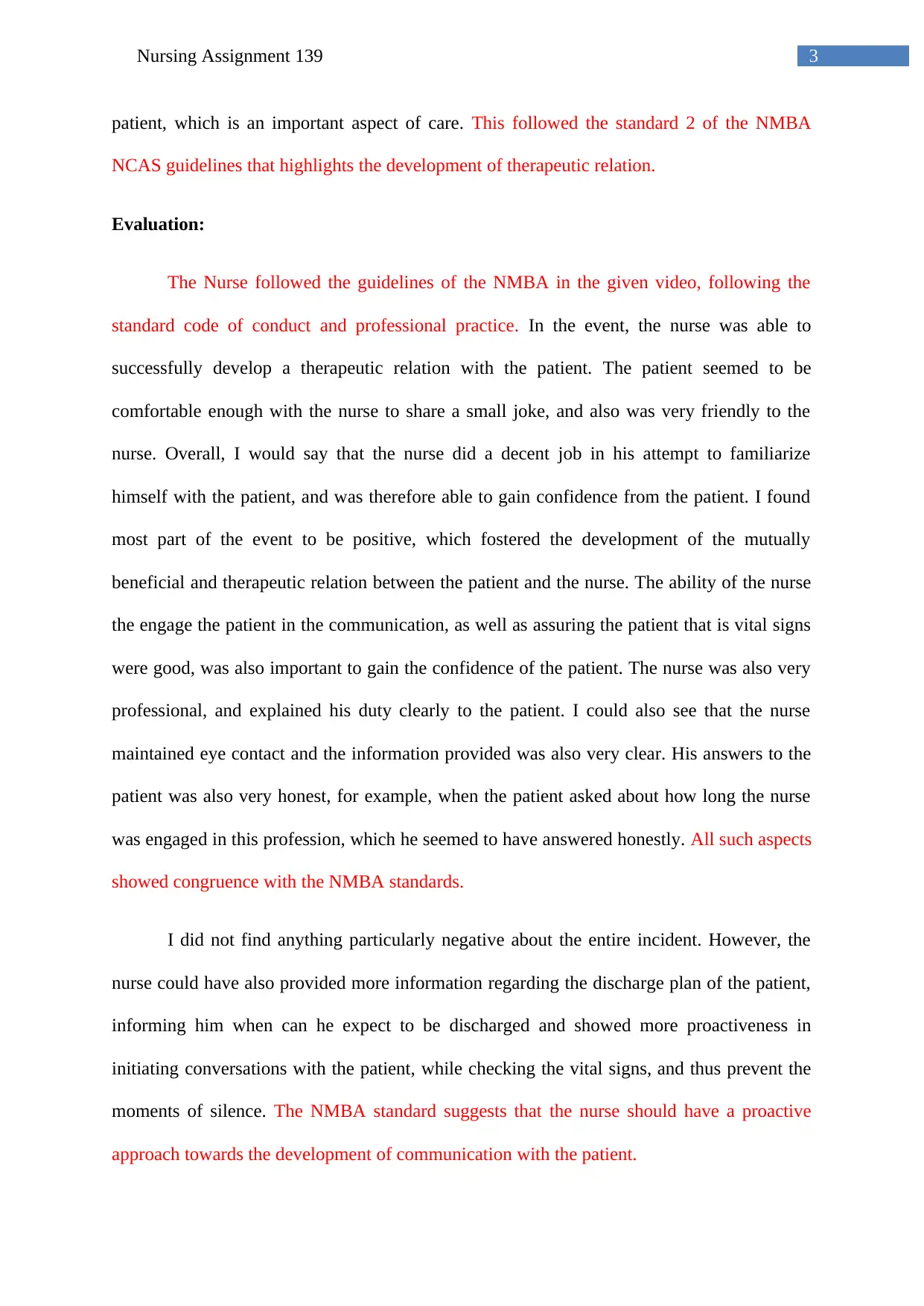
3Nursing Assignment 139
patient, which is an important aspect of care. This followed the standard 2 of the NMBA
NCAS guidelines that highlights the development of therapeutic relation.
Evaluation:
The Nurse followed the guidelines of the NMBA in the given video, following the
standard code of conduct and professional practice. In the event, the nurse was able to
successfully develop a therapeutic relation with the patient. The patient seemed to be
comfortable enough with the nurse to share a small joke, and also was very friendly to the
nurse. Overall, I would say that the nurse did a decent job in his attempt to familiarize
himself with the patient, and was therefore able to gain confidence from the patient. I found
most part of the event to be positive, which fostered the development of the mutually
beneficial and therapeutic relation between the patient and the nurse. The ability of the nurse
the engage the patient in the communication, as well as assuring the patient that is vital signs
were good, was also important to gain the confidence of the patient. The nurse was also very
professional, and explained his duty clearly to the patient. I could also see that the nurse
maintained eye contact and the information provided was also very clear. His answers to the
patient was also very honest, for example, when the patient asked about how long the nurse
was engaged in this profession, which he seemed to have answered honestly. All such aspects
showed congruence with the NMBA standards.
I did not find anything particularly negative about the entire incident. However, the
nurse could have also provided more information regarding the discharge plan of the patient,
informing him when can he expect to be discharged and showed more proactiveness in
initiating conversations with the patient, while checking the vital signs, and thus prevent the
moments of silence. The NMBA standard suggests that the nurse should have a proactive
approach towards the development of communication with the patient.
patient, which is an important aspect of care. This followed the standard 2 of the NMBA
NCAS guidelines that highlights the development of therapeutic relation.
Evaluation:
The Nurse followed the guidelines of the NMBA in the given video, following the
standard code of conduct and professional practice. In the event, the nurse was able to
successfully develop a therapeutic relation with the patient. The patient seemed to be
comfortable enough with the nurse to share a small joke, and also was very friendly to the
nurse. Overall, I would say that the nurse did a decent job in his attempt to familiarize
himself with the patient, and was therefore able to gain confidence from the patient. I found
most part of the event to be positive, which fostered the development of the mutually
beneficial and therapeutic relation between the patient and the nurse. The ability of the nurse
the engage the patient in the communication, as well as assuring the patient that is vital signs
were good, was also important to gain the confidence of the patient. The nurse was also very
professional, and explained his duty clearly to the patient. I could also see that the nurse
maintained eye contact and the information provided was also very clear. His answers to the
patient was also very honest, for example, when the patient asked about how long the nurse
was engaged in this profession, which he seemed to have answered honestly. All such aspects
showed congruence with the NMBA standards.
I did not find anything particularly negative about the entire incident. However, the
nurse could have also provided more information regarding the discharge plan of the patient,
informing him when can he expect to be discharged and showed more proactiveness in
initiating conversations with the patient, while checking the vital signs, and thus prevent the
moments of silence. The NMBA standard suggests that the nurse should have a proactive
approach towards the development of communication with the patient.
Secure Best Marks with AI Grader
Need help grading? Try our AI Grader for instant feedback on your assignments.
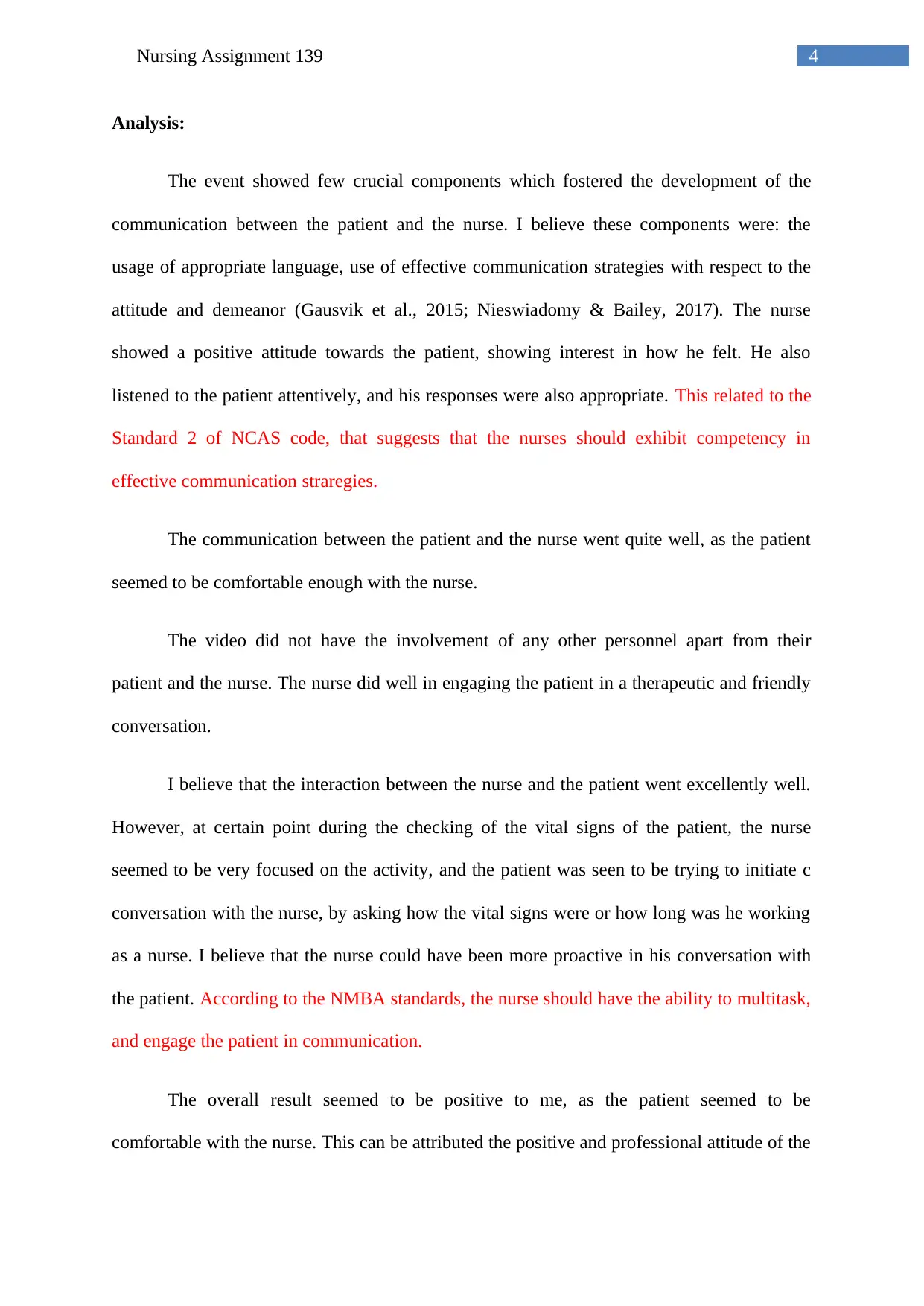
4Nursing Assignment 139
Analysis:
The event showed few crucial components which fostered the development of the
communication between the patient and the nurse. I believe these components were: the
usage of appropriate language, use of effective communication strategies with respect to the
attitude and demeanor (Gausvik et al., 2015; Nieswiadomy & Bailey, 2017). The nurse
showed a positive attitude towards the patient, showing interest in how he felt. He also
listened to the patient attentively, and his responses were also appropriate. This related to the
Standard 2 of NCAS code, that suggests that the nurses should exhibit competency in
effective communication straregies.
The communication between the patient and the nurse went quite well, as the patient
seemed to be comfortable enough with the nurse.
The video did not have the involvement of any other personnel apart from their
patient and the nurse. The nurse did well in engaging the patient in a therapeutic and friendly
conversation.
I believe that the interaction between the nurse and the patient went excellently well.
However, at certain point during the checking of the vital signs of the patient, the nurse
seemed to be very focused on the activity, and the patient was seen to be trying to initiate c
conversation with the nurse, by asking how the vital signs were or how long was he working
as a nurse. I believe that the nurse could have been more proactive in his conversation with
the patient. According to the NMBA standards, the nurse should have the ability to multitask,
and engage the patient in communication.
The overall result seemed to be positive to me, as the patient seemed to be
comfortable with the nurse. This can be attributed the positive and professional attitude of the
Analysis:
The event showed few crucial components which fostered the development of the
communication between the patient and the nurse. I believe these components were: the
usage of appropriate language, use of effective communication strategies with respect to the
attitude and demeanor (Gausvik et al., 2015; Nieswiadomy & Bailey, 2017). The nurse
showed a positive attitude towards the patient, showing interest in how he felt. He also
listened to the patient attentively, and his responses were also appropriate. This related to the
Standard 2 of NCAS code, that suggests that the nurses should exhibit competency in
effective communication straregies.
The communication between the patient and the nurse went quite well, as the patient
seemed to be comfortable enough with the nurse.
The video did not have the involvement of any other personnel apart from their
patient and the nurse. The nurse did well in engaging the patient in a therapeutic and friendly
conversation.
I believe that the interaction between the nurse and the patient went excellently well.
However, at certain point during the checking of the vital signs of the patient, the nurse
seemed to be very focused on the activity, and the patient was seen to be trying to initiate c
conversation with the nurse, by asking how the vital signs were or how long was he working
as a nurse. I believe that the nurse could have been more proactive in his conversation with
the patient. According to the NMBA standards, the nurse should have the ability to multitask,
and engage the patient in communication.
The overall result seemed to be positive to me, as the patient seemed to be
comfortable with the nurse. This can be attributed the positive and professional attitude of the
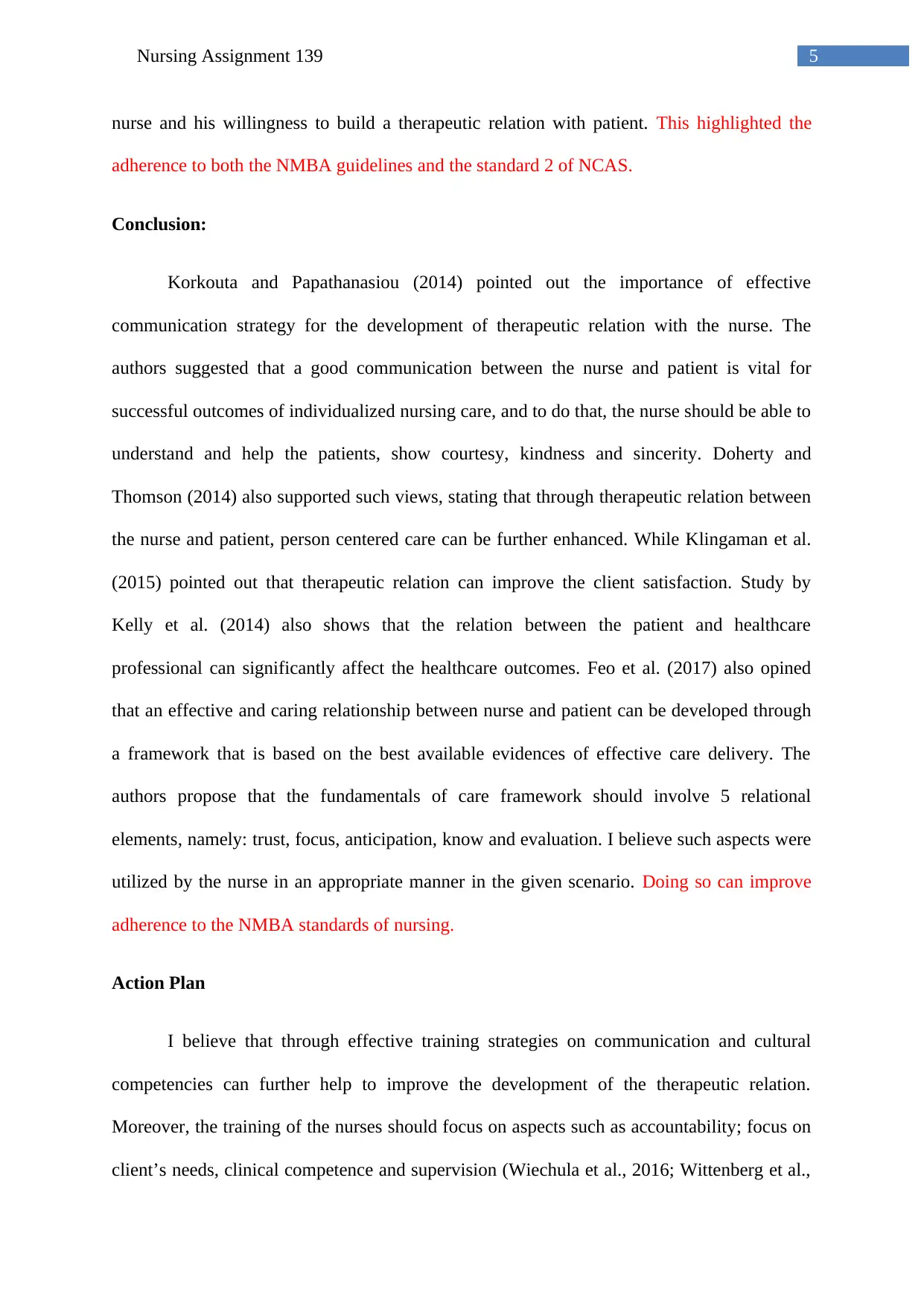
5Nursing Assignment 139
nurse and his willingness to build a therapeutic relation with patient. This highlighted the
adherence to both the NMBA guidelines and the standard 2 of NCAS.
Conclusion:
Korkouta and Papathanasiou (2014) pointed out the importance of effective
communication strategy for the development of therapeutic relation with the nurse. The
authors suggested that a good communication between the nurse and patient is vital for
successful outcomes of individualized nursing care, and to do that, the nurse should be able to
understand and help the patients, show courtesy, kindness and sincerity. Doherty and
Thomson (2014) also supported such views, stating that through therapeutic relation between
the nurse and patient, person centered care can be further enhanced. While Klingaman et al.
(2015) pointed out that therapeutic relation can improve the client satisfaction. Study by
Kelly et al. (2014) also shows that the relation between the patient and healthcare
professional can significantly affect the healthcare outcomes. Feo et al. (2017) also opined
that an effective and caring relationship between nurse and patient can be developed through
a framework that is based on the best available evidences of effective care delivery. The
authors propose that the fundamentals of care framework should involve 5 relational
elements, namely: trust, focus, anticipation, know and evaluation. I believe such aspects were
utilized by the nurse in an appropriate manner in the given scenario. Doing so can improve
adherence to the NMBA standards of nursing.
Action Plan
I believe that through effective training strategies on communication and cultural
competencies can further help to improve the development of the therapeutic relation.
Moreover, the training of the nurses should focus on aspects such as accountability; focus on
client’s needs, clinical competence and supervision (Wiechula et al., 2016; Wittenberg et al.,
nurse and his willingness to build a therapeutic relation with patient. This highlighted the
adherence to both the NMBA guidelines and the standard 2 of NCAS.
Conclusion:
Korkouta and Papathanasiou (2014) pointed out the importance of effective
communication strategy for the development of therapeutic relation with the nurse. The
authors suggested that a good communication between the nurse and patient is vital for
successful outcomes of individualized nursing care, and to do that, the nurse should be able to
understand and help the patients, show courtesy, kindness and sincerity. Doherty and
Thomson (2014) also supported such views, stating that through therapeutic relation between
the nurse and patient, person centered care can be further enhanced. While Klingaman et al.
(2015) pointed out that therapeutic relation can improve the client satisfaction. Study by
Kelly et al. (2014) also shows that the relation between the patient and healthcare
professional can significantly affect the healthcare outcomes. Feo et al. (2017) also opined
that an effective and caring relationship between nurse and patient can be developed through
a framework that is based on the best available evidences of effective care delivery. The
authors propose that the fundamentals of care framework should involve 5 relational
elements, namely: trust, focus, anticipation, know and evaluation. I believe such aspects were
utilized by the nurse in an appropriate manner in the given scenario. Doing so can improve
adherence to the NMBA standards of nursing.
Action Plan
I believe that through effective training strategies on communication and cultural
competencies can further help to improve the development of the therapeutic relation.
Moreover, the training of the nurses should focus on aspects such as accountability; focus on
client’s needs, clinical competence and supervision (Wiechula et al., 2016; Wittenberg et al.,
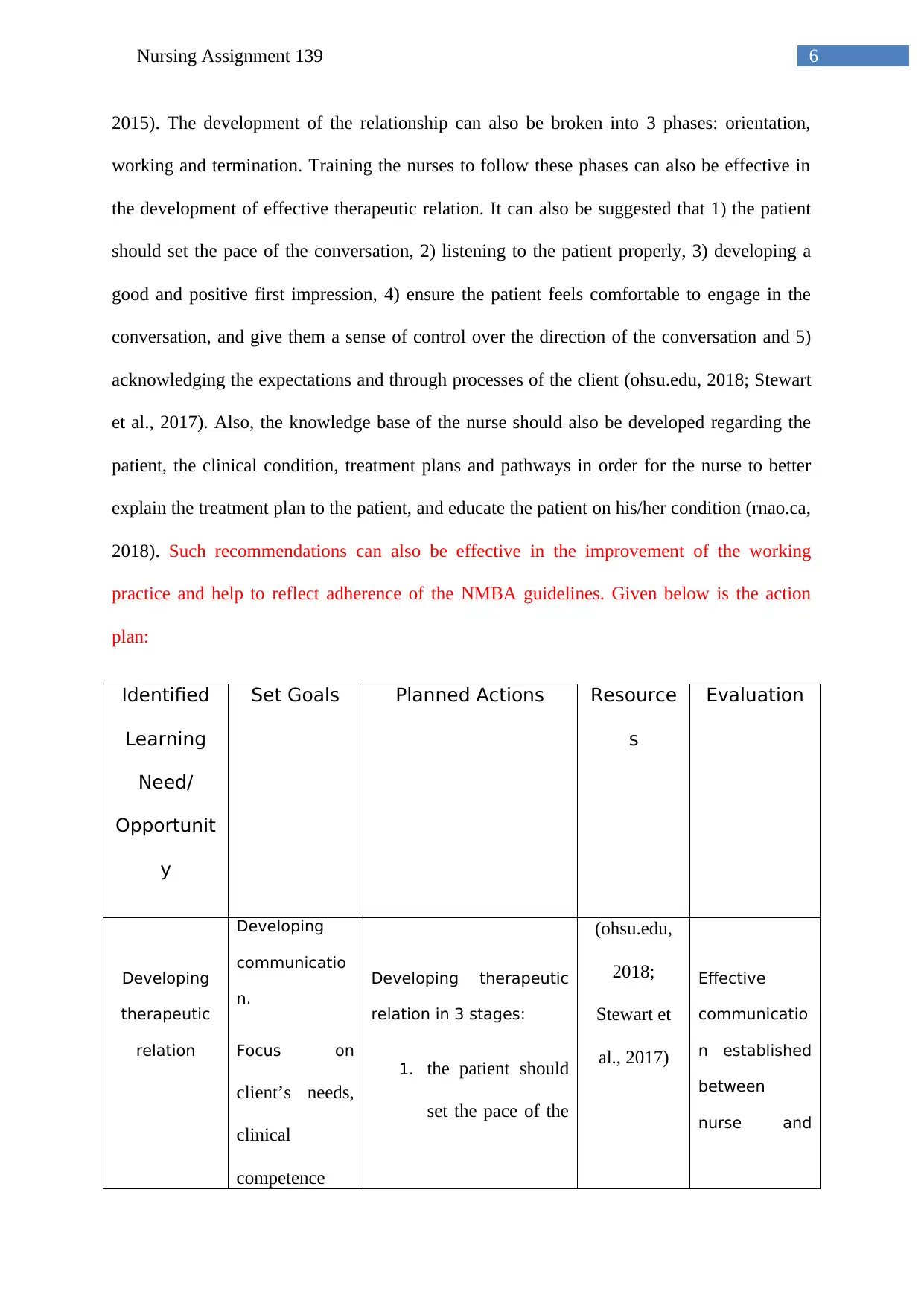
6Nursing Assignment 139
2015). The development of the relationship can also be broken into 3 phases: orientation,
working and termination. Training the nurses to follow these phases can also be effective in
the development of effective therapeutic relation. It can also be suggested that 1) the patient
should set the pace of the conversation, 2) listening to the patient properly, 3) developing a
good and positive first impression, 4) ensure the patient feels comfortable to engage in the
conversation, and give them a sense of control over the direction of the conversation and 5)
acknowledging the expectations and through processes of the client (ohsu.edu, 2018; Stewart
et al., 2017). Also, the knowledge base of the nurse should also be developed regarding the
patient, the clinical condition, treatment plans and pathways in order for the nurse to better
explain the treatment plan to the patient, and educate the patient on his/her condition (rnao.ca,
2018). Such recommendations can also be effective in the improvement of the working
practice and help to reflect adherence of the NMBA guidelines. Given below is the action
plan:
Identified
Learning
Need/
Opportunit
y
Set Goals Planned Actions Resource
s
Evaluation
Developing
therapeutic
relation
Developing
communicatio
n.
Focus on
client’s needs,
clinical
competence
Developing therapeutic
relation in 3 stages:
1. the patient should
set the pace of the
(ohsu.edu,
2018;
Stewart et
al., 2017)
Effective
communicatio
n established
between
nurse and
2015). The development of the relationship can also be broken into 3 phases: orientation,
working and termination. Training the nurses to follow these phases can also be effective in
the development of effective therapeutic relation. It can also be suggested that 1) the patient
should set the pace of the conversation, 2) listening to the patient properly, 3) developing a
good and positive first impression, 4) ensure the patient feels comfortable to engage in the
conversation, and give them a sense of control over the direction of the conversation and 5)
acknowledging the expectations and through processes of the client (ohsu.edu, 2018; Stewart
et al., 2017). Also, the knowledge base of the nurse should also be developed regarding the
patient, the clinical condition, treatment plans and pathways in order for the nurse to better
explain the treatment plan to the patient, and educate the patient on his/her condition (rnao.ca,
2018). Such recommendations can also be effective in the improvement of the working
practice and help to reflect adherence of the NMBA guidelines. Given below is the action
plan:
Identified
Learning
Need/
Opportunit
y
Set Goals Planned Actions Resource
s
Evaluation
Developing
therapeutic
relation
Developing
communicatio
n.
Focus on
client’s needs,
clinical
competence
Developing therapeutic
relation in 3 stages:
1. the patient should
set the pace of the
(ohsu.edu,
2018;
Stewart et
al., 2017)
Effective
communicatio
n established
between
nurse and
Paraphrase This Document
Need a fresh take? Get an instant paraphrase of this document with our AI Paraphraser
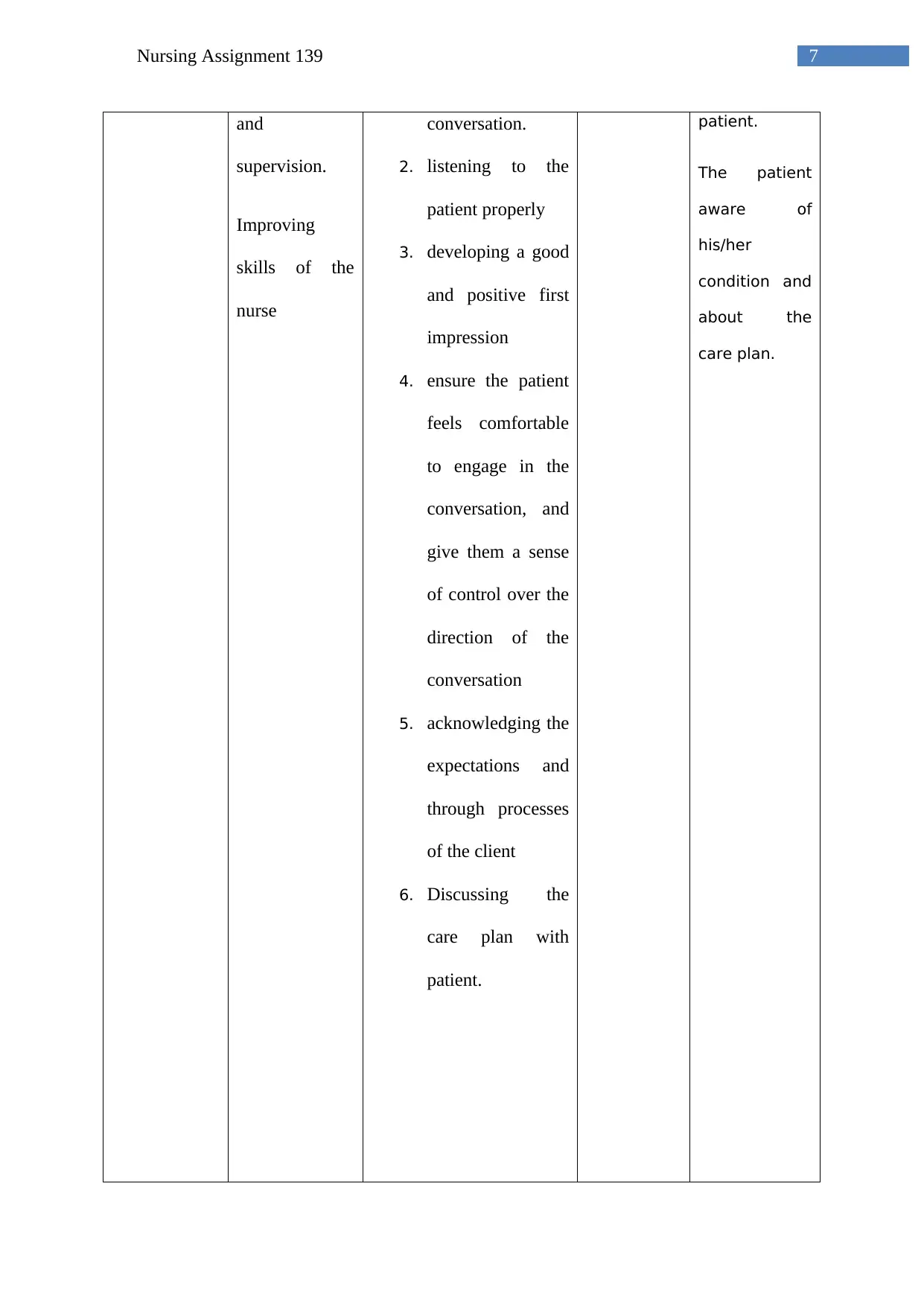
7Nursing Assignment 139
and
supervision.
Improving
skills of the
nurse
conversation.
2. listening to the
patient properly
3. developing a good
and positive first
impression
4. ensure the patient
feels comfortable
to engage in the
conversation, and
give them a sense
of control over the
direction of the
conversation
5. acknowledging the
expectations and
through processes
of the client
6. Discussing the
care plan with
patient.
patient.
The patient
aware of
his/her
condition and
about the
care plan.
and
supervision.
Improving
skills of the
nurse
conversation.
2. listening to the
patient properly
3. developing a good
and positive first
impression
4. ensure the patient
feels comfortable
to engage in the
conversation, and
give them a sense
of control over the
direction of the
conversation
5. acknowledging the
expectations and
through processes
of the client
6. Discussing the
care plan with
patient.
patient.
The patient
aware of
his/her
condition and
about the
care plan.

8Nursing Assignment 139
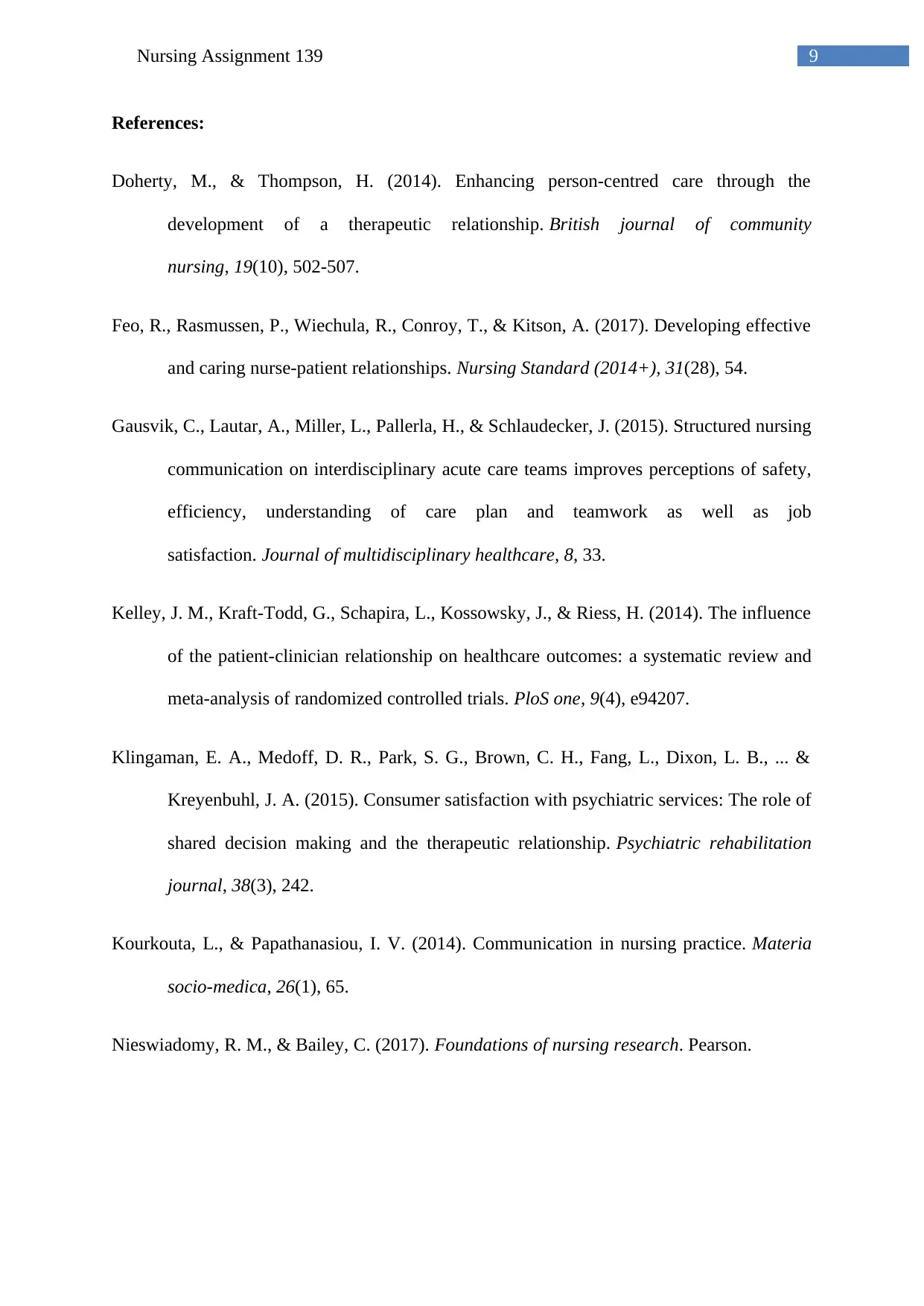
9Nursing Assignment 139
References:
Doherty, M., & Thompson, H. (2014). Enhancing person-centred care through the
development of a therapeutic relationship. British journal of community
nursing, 19(10), 502-507.
Feo, R., Rasmussen, P., Wiechula, R., Conroy, T., & Kitson, A. (2017). Developing effective
and caring nurse-patient relationships. Nursing Standard (2014+), 31(28), 54.
Gausvik, C., Lautar, A., Miller, L., Pallerla, H., & Schlaudecker, J. (2015). Structured nursing
communication on interdisciplinary acute care teams improves perceptions of safety,
efficiency, understanding of care plan and teamwork as well as job
satisfaction. Journal of multidisciplinary healthcare, 8, 33.
Kelley, J. M., Kraft-Todd, G., Schapira, L., Kossowsky, J., & Riess, H. (2014). The influence
of the patient-clinician relationship on healthcare outcomes: a systematic review and
meta-analysis of randomized controlled trials. PloS one, 9(4), e94207.
Klingaman, E. A., Medoff, D. R., Park, S. G., Brown, C. H., Fang, L., Dixon, L. B., ... &
Kreyenbuhl, J. A. (2015). Consumer satisfaction with psychiatric services: The role of
shared decision making and the therapeutic relationship. Psychiatric rehabilitation
journal, 38(3), 242.
Kourkouta, L., & Papathanasiou, I. V. (2014). Communication in nursing practice. Materia
socio-medica, 26(1), 65.
Nieswiadomy, R. M., & Bailey, C. (2017). Foundations of nursing research. Pearson.
References:
Doherty, M., & Thompson, H. (2014). Enhancing person-centred care through the
development of a therapeutic relationship. British journal of community
nursing, 19(10), 502-507.
Feo, R., Rasmussen, P., Wiechula, R., Conroy, T., & Kitson, A. (2017). Developing effective
and caring nurse-patient relationships. Nursing Standard (2014+), 31(28), 54.
Gausvik, C., Lautar, A., Miller, L., Pallerla, H., & Schlaudecker, J. (2015). Structured nursing
communication on interdisciplinary acute care teams improves perceptions of safety,
efficiency, understanding of care plan and teamwork as well as job
satisfaction. Journal of multidisciplinary healthcare, 8, 33.
Kelley, J. M., Kraft-Todd, G., Schapira, L., Kossowsky, J., & Riess, H. (2014). The influence
of the patient-clinician relationship on healthcare outcomes: a systematic review and
meta-analysis of randomized controlled trials. PloS one, 9(4), e94207.
Klingaman, E. A., Medoff, D. R., Park, S. G., Brown, C. H., Fang, L., Dixon, L. B., ... &
Kreyenbuhl, J. A. (2015). Consumer satisfaction with psychiatric services: The role of
shared decision making and the therapeutic relationship. Psychiatric rehabilitation
journal, 38(3), 242.
Kourkouta, L., & Papathanasiou, I. V. (2014). Communication in nursing practice. Materia
socio-medica, 26(1), 65.
Nieswiadomy, R. M., & Bailey, C. (2017). Foundations of nursing research. Pearson.
Secure Best Marks with AI Grader
Need help grading? Try our AI Grader for instant feedback on your assignments.
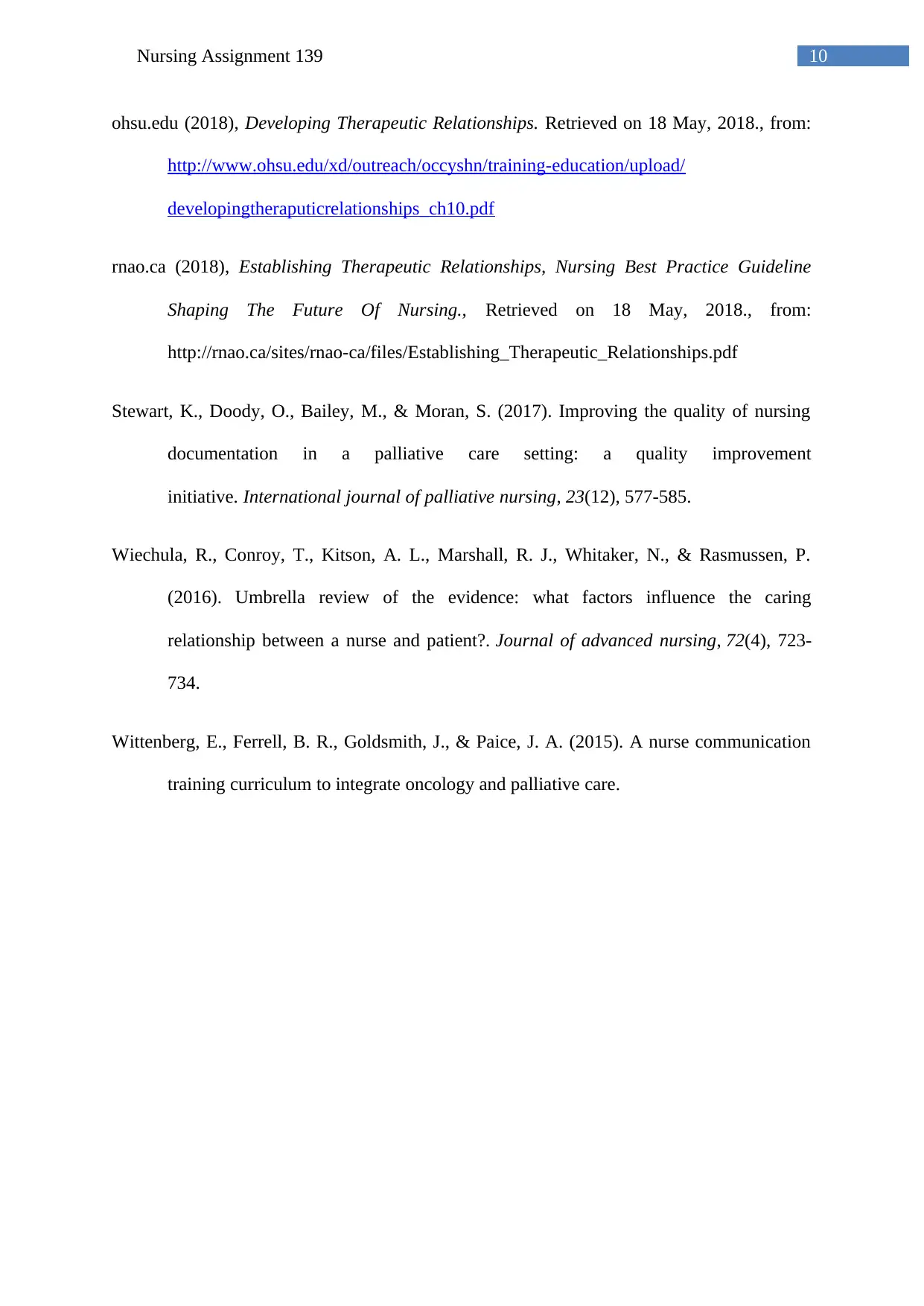
10Nursing Assignment 139
ohsu.edu (2018), Developing Therapeutic Relationships. Retrieved on 18 May, 2018., from:
http://www.ohsu.edu/xd/outreach/occyshn/training-education/upload/
developingtheraputicrelationships_ch10.pdf
rnao.ca (2018), Establishing Therapeutic Relationships, Nursing Best Practice Guideline
Shaping The Future Of Nursing., Retrieved on 18 May, 2018., from:
http://rnao.ca/sites/rnao-ca/files/Establishing_Therapeutic_Relationships.pdf
Stewart, K., Doody, O., Bailey, M., & Moran, S. (2017). Improving the quality of nursing
documentation in a palliative care setting: a quality improvement
initiative. International journal of palliative nursing, 23(12), 577-585.
Wiechula, R., Conroy, T., Kitson, A. L., Marshall, R. J., Whitaker, N., & Rasmussen, P.
(2016). Umbrella review of the evidence: what factors influence the caring
relationship between a nurse and patient?. Journal of advanced nursing, 72(4), 723-
734.
Wittenberg, E., Ferrell, B. R., Goldsmith, J., & Paice, J. A. (2015). A nurse communication
training curriculum to integrate oncology and palliative care.
ohsu.edu (2018), Developing Therapeutic Relationships. Retrieved on 18 May, 2018., from:
http://www.ohsu.edu/xd/outreach/occyshn/training-education/upload/
developingtheraputicrelationships_ch10.pdf
rnao.ca (2018), Establishing Therapeutic Relationships, Nursing Best Practice Guideline
Shaping The Future Of Nursing., Retrieved on 18 May, 2018., from:
http://rnao.ca/sites/rnao-ca/files/Establishing_Therapeutic_Relationships.pdf
Stewart, K., Doody, O., Bailey, M., & Moran, S. (2017). Improving the quality of nursing
documentation in a palliative care setting: a quality improvement
initiative. International journal of palliative nursing, 23(12), 577-585.
Wiechula, R., Conroy, T., Kitson, A. L., Marshall, R. J., Whitaker, N., & Rasmussen, P.
(2016). Umbrella review of the evidence: what factors influence the caring
relationship between a nurse and patient?. Journal of advanced nursing, 72(4), 723-
734.
Wittenberg, E., Ferrell, B. R., Goldsmith, J., & Paice, J. A. (2015). A nurse communication
training curriculum to integrate oncology and palliative care.

11Nursing Assignment 139
1 out of 12
Related Documents
Your All-in-One AI-Powered Toolkit for Academic Success.
+13062052269
info@desklib.com
Available 24*7 on WhatsApp / Email
![[object Object]](/_next/static/media/star-bottom.7253800d.svg)
Unlock your academic potential
© 2024 | Zucol Services PVT LTD | All rights reserved.




